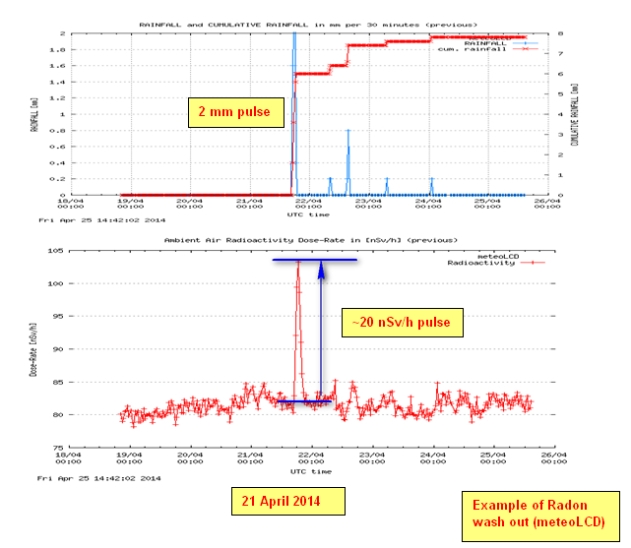In August 2013 I wrote a small comment on ambient air radioactivity peaks coincident with a sharp rain fall pulse. Several specialists like A. Kies and M. Severijnen confirmed that these observations show a wash out of the radioactive daughters of the ubiquitous radon gas. This year a similar event happened the 21th April 2014:
Note that the 2 mm rain fall pulse triggered a radiation rise of about 20 nSv/h above the base level. One also sees that the much lower rain fall pulse (0.8 mm) which happened the next day does only a minor radiation peak.
Several interesting questions can be asked:
1. Is there a minimum time between two rain fall pulses needed to cause strong radiation peaks?
Or in other words: how long does it take for the atmosphere aerosol content to recover after a first washout?
The observations made in August 2013 suggest that 1 day could be enough:
The first rain pulse (1.2 mm) causes a radiation peak of about 14 nSv/h; the second much stronger rain pulse (2.2 mm) triggers a radiation peak of comparable amplitude: this could be a hint that the atmospheric aerosol load has not quite recovered to the previous level (which would be the base line after 3 dry days).
A week in September 2013 gives a similar picture:
Here we see two strong similar rain pulses of about 4 mm separated by about 48 hours: the first triggers a radiation peak of about 35 nSv/h. and the second of only 15 nSv/h. A close inspection shows that this second rain pulse actually is double, a first of 2.8 mm followed a couple of hours by a second of 4 mm. The radiation curve peak also shows these two peaks, with again the second (corresponding to a higher rain fall) less than the first.
The conclusion is that a simple relation-ship of the form radiation-peak = f(rain pulse) can not be established without respecting this atmospheric recovery time lapse.
2. Is the radiation peak proportional to the rain fall pulse?
Using only our miniscule set of observations from 2013 and 2014, let us just keep the (rain pulse, radiation peak) points separated by a minimum of 3 dry days:
The plot shows that the slope of the regression line is 7.09. i.e. the first rain-fall pulse of 1 mm causes on average a radiation peak of 7 nSv/h. The goodness of the fit is rather poor (R2 = 0.28), and this analysis shouts for more data!
Conclusion:
An analysis of the relationship between rain pulse and radiation peak intensities must respect the time lapse needed for the recovery of atmospheric aerosol load, possibly 3 dry consecutive days . This first short study suggests a possible linear relationship with a slope of 7 (nSV/h)/mm .




September 25, 2019 at 17:20 |
[…] Many times I wrote on this blog on radon washout: after a short downpour, we (nearly) always see a visible peak in our gamma radiation, caused by a washout of the daughters of the noble gas radon which is a natural constituent of our atmosphere; to find these comments enter “radon” into the search window on this site or click here , here and here. […]
May 19, 2021 at 10:56 |
[…] washout […]
July 27, 2021 at 14:30 |
[…] to radon washout, the ambient gamma radiation shows sometimes impressive peaks ( see here, here, here, here, here, […]